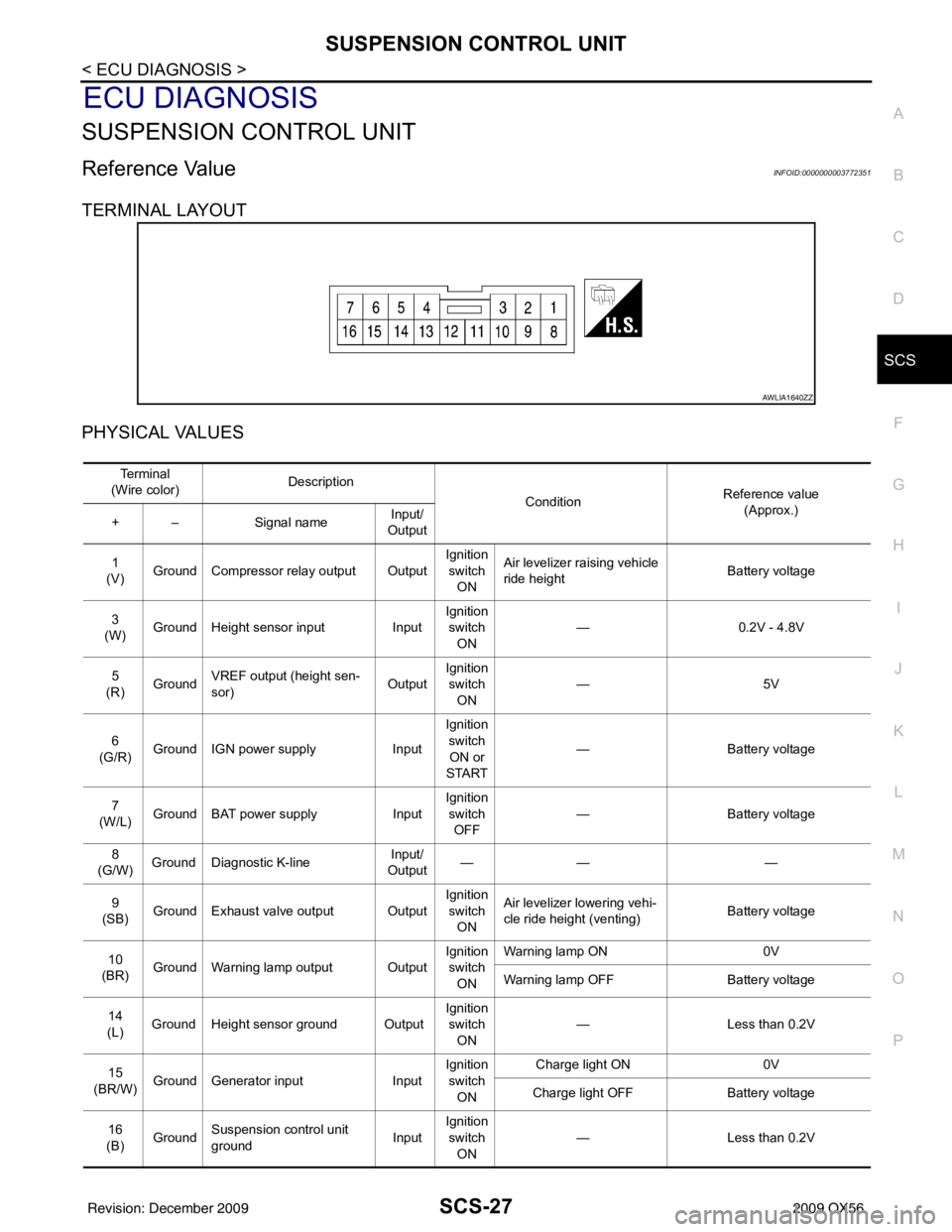Page 3190 of 4171

SB-12
< ON-VEHICLE REPAIR >
SEAT BELTS
4. Check the shoulder seat belt guide and shoulder belt height adjuster for\
front seats. Ensure guide swivelsfreely and that belt lays flat and does not bind in guide. Ensure height adjuster operates properly and
holds securely.
5. Check retractor operation:
a. Fully extend the seat belt webbing and check for twists, tears or other damage.
b. Allow the seat belt to retract. Ensure that belt retu rns smoothly and completely into the retractor. If the
seat belt does not return smoothly, wipe the inside of the loops with a clean paper cloth, because dirt built
up in the loops of the upper anchors can c ause the seat belts to retract slowly.
c. Fasten the seat belt. Check the seat belt returns smoothly and completely to the retractor. If the belt does not return smoothly, the cause may be an accumulati on of dust or dirt. Use the “SEAT BELT TAPE SET”
and perform the following steps.
Inspect the front seat belt through-anchor:1. Pull the seat belt out to a length of 500 mm (19.69 in) or more.
2. Use a clip or other device to hold the seat belt at the center pillar belt opening.
3. Pass a thin wire through the through-anchor belt opening. Hold both ends of the wire and pull taut while moving it up and down several times along the belt opening surface to remove dirt.
4. Any dirt that cannot be removed with the wir e can be removed by cleaning the opening with a clean
cloth.
5. Apply tape at the point where the belt contacts the through-anchor belt opening.
NOTE:
Apply the tape so that there is no looseness or wrinkling.
6. Remove the clip holding the seat belt and check that the belt returns smoothly.
7. Repeat steps above as necessary to check the other seat belts.
SEAT BELT RETRACTOR ON-VEHICLE CHECK
Emergency Locking Retractors (ELR) and Automatic Locking Retractors (ALR)
NOTE:
All seat belt retractors are of the Emergency Locking Retractors (ELR) type. In an emergency (sudden stop)
the retractor will lock and prevent the belt from ext ending any further. All 3-point type seat belt retractors
except the driver's seat belt also have an Automati c Locking Retractors (ALR) mode. The ALR mode (also
called child restraint mode) is used when installing child seats. The ALR mode is activated when the seat belt
is fully extended. When the belt is then retracted partiall y, the ALR mode automatically locks the seat belt in a
specific position so the belt cannot be extended any furt her. To cancel the ALR mode, allow the seat belt to
fully wind back into the retractor.
Check the seat belt retractors using the following test(s ) to determine if a seat belt retractor and belt assembly
is operating properly.
ELR Function Stationary Check
Grasp the shoulder belt and pull forward quickly. The re tractor should lock and prevent the belt from extending
further.
ALR Function Stationary Check
1. Pull out entire length of seat belt from retractor until a click is heard.
2. Retract the belt partially. A clicking noise should be hear d as the belt retracts indicating that the retractor is
in the Automatic Locking Retractor (ALR) mode.
3. Grasp the seat belt and try to pull out the retractor. The belt must lock and not extend any further. If neces-
sary replace the seat belt retractor and belt assembly.
4. Allow the entire length of the belt to re tract to cancel the automatic locking mode.
ELR Function Moving Check
WARNING:
Perform the following test in a safe, open area clear of other vehicles and obstructions (for example, a
large, empty parking lot). Road surface must be p aved and dry. DO NOT perform the following test on
wet or gravel roads or on public streets and highw ays. This could result in an accident and serious
personal injury. The driver and passenger must be prepared to brace themselves in the event the
retractor does not lock.
1. Fasten drivers seat belt. Buckle a passenger in to the seat for the belt that is to be tested.
Revision: December 20092009 QX56
Page 3195 of 4171

SCS-2
EXHAUST VALVE SOLENOID CIRCUIT ..........23
Description ........................................................... ...23
Component Function Check ...................................23
Diagnosis Procedure ..............................................23
CK SUSP WARNING INDICATOR CONTROL
CIRCUIT .............................................................
25
Description ........................................................... ...25
Component Function Check ...................................25
Diagnosis Procedure ..............................................25
ECU DIAGNOSIS ..................................... ...27
SUSPENSION CONTROL UNIT ........................27
Reference Value .................................................. ...27
Wiring Diagram .......................................................28
DTC Index ..............................................................33
SYMPTOM DIAGNOSIS .............................35
SUSPENSION CONTROL SYSTEM .............. ...35
Symptom Table ................................................... ...35
SUSPENSION CONTROL SYSTEM INOPER-
ATIVE .................................................................
36
Description ........................................................... ...36
Diagnosis Procedure ...............................................36
SUSPENSION CONTROL SYSTEM DOES
NOT RAISE ........................................................
37
Description ........................................................... ...37
Diagnosis Procedure ...............................................37
SUSPENSION CONTROL SYSTEM DOES
NOT LOWER .....................................................
38
Description ........................................................... ...38
Diagnosis Procedure ...............................................38
PRECAUTION ............................................39
PRECAUTIONS .............................................. ...39
Precaution for Supplemental Restraint System
(SRS) "AIR BAG" and "SEAT BELT PRE-TEN-
SIONER" .............................................................. ...
39
Precaution for Rear Suspension .............................39
Revision: December 20092009 QX56
Page 3200 of 4171

DIAGNOSIS SYSTEM (SUSPENSION CONTROL UNIT)
SCS-7
< FUNCTION DIAGNOSIS >
C
D F
G H
I
J
K L
M A
B
SCS
N
O P
DIAGNOSIS SYSTEM (SUS PENSION CONTROL UNIT)
CONSULT-III FunctionINFOID:0000000003772311
CONSULT-III can display each diagnostic item using the diagnostic test modes shown following.
WORK SUPPORT
Display Item List
DATA MONITOR
Display Item List
ACTIVE TEST
CAUTION:
Do not perform active test while driving.
Display Item List
AIR LEVELIZER diagnosis mode Description
WORK SUPPORT Supports inspection and adjustment. Commands are transmitted to the suspension control
unit for setting the status suitable for required operation, input/output signals are received
from the suspension control unit and received data is displayed.
SELF-DIAG RESULTS Displays suspension control unit self-diagnosis results.
DATA MONITOR Displays suspension control unit input/output data in real time.
ACTIVE TEST Operation of electrical loads can be checked by sending drive signal to them.
ECU PART NUMBER The part number of suspension control unit can be checked.
ItemDescription Condition
STANDARD HEIGHT LEVEL Resets the vehicle height to the initialization flag
setting stored in the suspension control unit. Vehicle unladen, set in a horizontal position and
not moving.
NOTE:
Do not take your eyes off the vehicle while CON-
SULT-III is processing.
ADJUST HEIGHT INI Sets the height initialization flag in the suspen-
sion control unit when the control unit has been
replaced or when the initialization flag has been
cleared using the "CLEAR HEIGHT INI" proce-
dure. Vehicle unladen, move vehicle forward and back-
ward approx. 5 m (16.4 ft) and rock vehicle side
to side.
NOTE:
Do not move vehicle wh
ile CONSULT-III is pro-
cessing.
CLEAR HEIGHT INI Clears the initialization flag in the suspension
control unit. Vehicle unladen.
Display item [unit] ALL
SIGNALS SELECTION FROM MENU
HEIGT SEN [V] XX
HEIGT CALC [mm] XX
SEN FIX TIME [HR] XX
HEIGT INI VAL [V] XX
COMPRESSOR [ON/OFF] XX
EXH SOLENOID [ON/OFF] XX
ACG L [ON/OFF] XX
Test Item Description
COMPRESSOR ON/OFF
Revision: December 20092009 QX56
Page 3220 of 4171

SUSPENSION CONTROL UNITSCS-27
< ECU DIAGNOSIS >
C
DF
G H
I
J
K L
M A
B
SCS
N
O P
ECU DIAGNOSIS
SUSPENSION CONTROL UNIT
Reference ValueINFOID:0000000003772351
TERMINAL LAYOUT
PHYSICAL VALUES
AWLIA1640ZZ
Te r m i n a l
(Wire color) Description
ConditionReference value
(Approx.)
+ – Signal nameInput/
Output
1
(V) Ground Compressor relay output Output Ignition
switch ON Air levelizer ra
ising vehicle
ride height Battery voltage
3
(W) Ground Height sensor input
InputIgnition
switch
ON —
0.2V - 4.8V
5
(R) Ground VREF output (height sen-
sor)
OutputIgnition
switch ON —5
V
6
(G/R) Ground IGN power supply
InputIgnition
switch ON or
START —
Battery voltage
7
(W/L) Ground BAT power supply
InputIgnition
switch OFF —
Battery voltage
8
(G/W) Ground Diagnostic K-line Input/
Output ——
—
9
(SB) Ground Exhaust valve output Output Ignition
switch ON Air levelizer lo
wering vehi-
cle ride height (venting) Battery voltage
10
(BR) Ground Warning lamp output Output Ignition
switch
ON Warning lamp ON
0V
Warning lamp OFF Battery voltage
14
(L) Ground Height sensor ground Output Ignition
switch ON —
Less than 0.2V
15
(BR/W) Ground Generator input
InputIgnition
switch ON Charge light ON
0V
Charge light OFF Battery voltage
16
(B) Ground
Suspension control unit
ground InputIgnition
switch
ON —
Less than 0.2V
Revision: December 20092009 QX56
Page 3221 of 4171
SCS-28
< ECU DIAGNOSIS >
SUSPENSION CONTROL UNIT
Wiring Diagram
INFOID:0000000003772352
ABEWA0006GB
Revision: December 20092009 QX56
Page 3222 of 4171
SUSPENSION CONTROL UNITSCS-29
< ECU DIAGNOSIS >
C
DF
G H
I
J
K L
M A
B
SCS
N
O P
ABEIA0014GB
Revision: December 20092009 QX56
Page 3223 of 4171
SCS-30
< ECU DIAGNOSIS >
SUSPENSION CONTROL UNIT
ABEIA0015GB
Revision: December 20092009 QX56
Page 3224 of 4171
SUSPENSION CONTROL UNITSCS-31
< ECU DIAGNOSIS >
C
DF
G H
I
J
K L
M A
B
SCS
N
O P
ABEIA0016GB
Revision: December 20092009 QX56